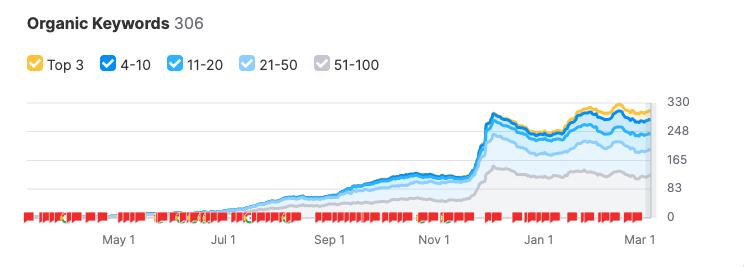SEO copywriting case study for a law firm
SEO is an important part of law firm marketing. Here we give you an example of how we ranked one practice area of a law firm on Page One of Google for 60 target keywords.
We’re a no-bullshit marketing agency for law firms, so as you’d expect, we aren’t coy when we write our website copywriting examples. In those case studies, we break down our thinking to show you how our website copywriters achieved results.
Things are different when it comes to SEO copywriting; we have to be discreet. That’s because the goals of SEO copywriting are to:
- Get our client’s webpage to rank in Google for particular keywords. That’s the search engine optimisation (SEO) part of the project.
- Persuade the readers of that page to take action. That’s the copywriting part of the project.
So we can hardly work to rank a client for a set of keywords then alert the competition to our client’s dominance for specific keywords, the exact page (or pages) our client is using to achieve that dominance and how we achieved that dominance.
What does this SEO copywriting example show?
If we have to be so discreet, what are we allowed to tell you?
- We can give you an outline of the project — an outline that would apply equally to any practice area of your law firm
- We can offer proof (albeit with redacted details) that SEO copywriting works as part of marketing for a law firm, so it could work for you if you want to get new clients from Google
- We can show you the value of the SEO copywriting to the client
Background to this law firm SEO example
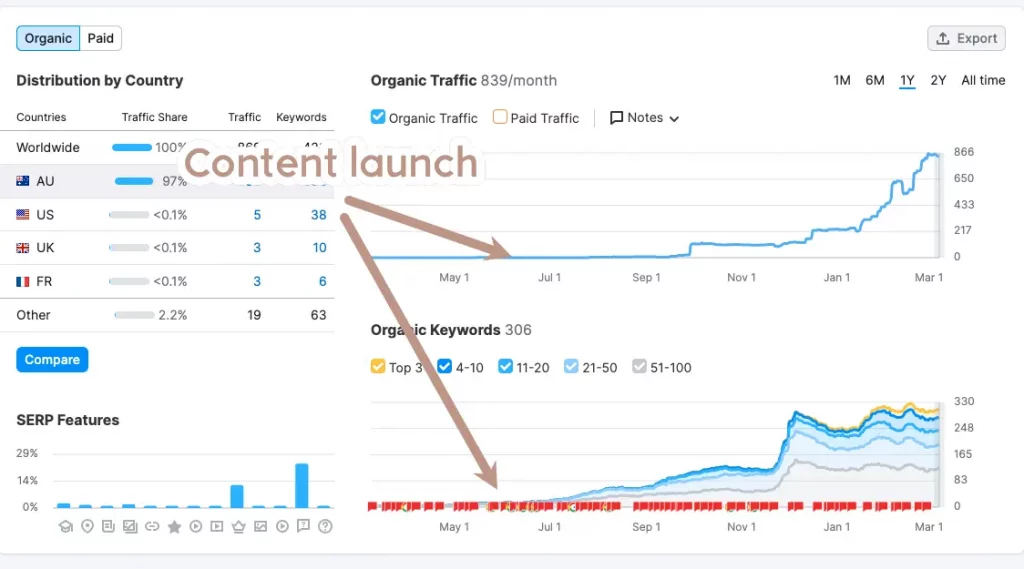
Summary of ranking data
| SEO copywriting publication date | June 2021 |
| Case study date | March 2022 (9 months later) |
| Keywords in top 100 at start of project | 17 |
| Keywords in top 100 now | 306 |
| Keywords in top 20 at start of project | 1 |
| Keywords in top 20 now | 110 |
| Keywords in top 10 at start of project | 0 |
| Keywords in top 10 now | 65 |
| Keywords in top 3 at start of project | 0 |
| Keywords in top 3 now | 25 |
Our client is a law firm in Australia. They launched their website in March 2020. Just over a year later, the firm commissioned us to write a blog post about a lucrative area of practice.
At that time, they did not rank for any keywords. (We had not done any SEO copywriting for the firm before the blog post that is the subject of this case study.) Nine months later, the lawyers could boast of 306 keywords in the top 100. And 200 of those keywords were ranking because of the blog post we wrote for the firm.
The result was a massive increase in traffic to the lawyers’ website (and commissions for Taleist to write more content about additional lucrative practice areas).
Writing the law firm’s blog post
Every Google search is a question, so writing a blog post about any area of legal practice means:
- Researching what questions are being asked
- Understanding the form in which Google expects the answers
- Reviewing the webpages and blog posts that are already ranking for those questions
- Designing an answer that is similar in structure (in order that Google will accept it) but better in content than the competition
Step 5 in writing a blog post for lawyers
To put the “copywriting” in SEO copywriting, the fifth step in the process is to write the content in a way that leaves the reader thinking, “I should get in touch with this law firm.”
Shaping the blog post for this area of law
Busting an SEO myth
You might have heard that the secret to ranking on Google is to write a little and often because that’s what Google likes. This was once true. Short, frequent blog posts could positively affect ranking in the past. That made those sorts of posts a common SEO tactic back in the day.
Today, if you have your fee earners putting out notes and updates of 500-800 words, they’re great:
- To send to clients by email or
- To have on your website for website visitors to read
But they will not rank in Google.
That’s because the story with SEO is different now, and that story doesn’t have a chapter for short posts.
There are a number of important reasons that Google now favours long, relevant posts. There isn’t room to go into those reasons here, but they are one of the foundations of our SEO Content Marketing Course.
Average length of an SEO optimised blog post
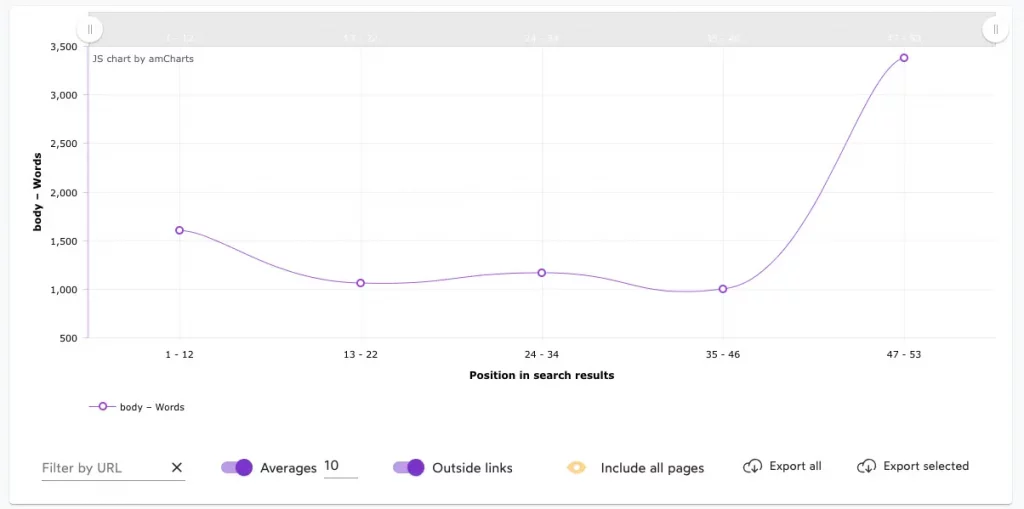
In the case of this legal blog post, we wrote almost 3,000 words. Full disclosure: that’s longer than the average length of the posts that rank on Page One of Google for the same keywords (1,598). (You can see the Page One averages on the far left of the graph above.)
As a result, you could argue that the length of our post is over the top. However, the results suggest that we were right to aim for dominance. This post ranks for a massive 200 keywords. A large part of that dominance is due to the post’s comprehensive approach to the topic.
Depth of content for SEO
There’s no argument that Google likes content long these days (on the whole). However, you won’t rank in search engines by taking a short post and making it longer by adding gibberish.
The Google algorithm could be thought of as like a reasonably educated reader. The algorithm knows nonsense when it sees it. Google knows:
- What’s good English — grammar, spelling, sentence structure, etc.
- What’s written well-enough to be enjoyable. (Think Flesch Kincaid Grade Level.)
You can’t get away with blatant padding either. Search engines are smart enough to know if your 3,000 words are:
✅ Good: Deep enough to be relevant to the reader’s question and to answer the reader’s next question as well OR
❌ Bad: Empty, repetitive, irrelevant words designed to make your post look substantial at first glance when in fact your post wanders off-topic or collapses into nonsense that won’t be useful to the reader.
Google doesn’t have to guess whether your post should be on the naughty or the nice list.
- Google takes your content offering and compares it to your competition. How do you stack up? Are you covering the same things? Are you covering them as deeply? More deeply? Clearer?
- Google knows what webpages searchers have found valuable previously. So Google compares your offering. Is your offering better in a material way than the content that Google is already ranking? If it isn’t, why would Google reshuffle the deck?
As a result, when it comes to what will give your post a chance of outranking the competition, you don’t have to guess, either. If you know how Google makes its evaluations, you can use those criteria to analyse what’s already ranking. Then you can use that analysis to work out how to beat your competitors. (When it comes to the analysis and the expectation, we can teach you the SEO skills and tools to do that or we can do it for you.)
In the case of this blog post for our law firm client, we got to 3,000 words by fully understanding the competition and the potential to beat them. As a result of that research and executing on it:
- The legal post ranks for 200 keywords in total, half of them in the top 20
- The law firm’s post appears on the first page of Google for 60 keywords, achieving a top 3 ranking for 24 of those keywords
- The post appears in 15 featured snippets (see below for an example of a featured snippet)
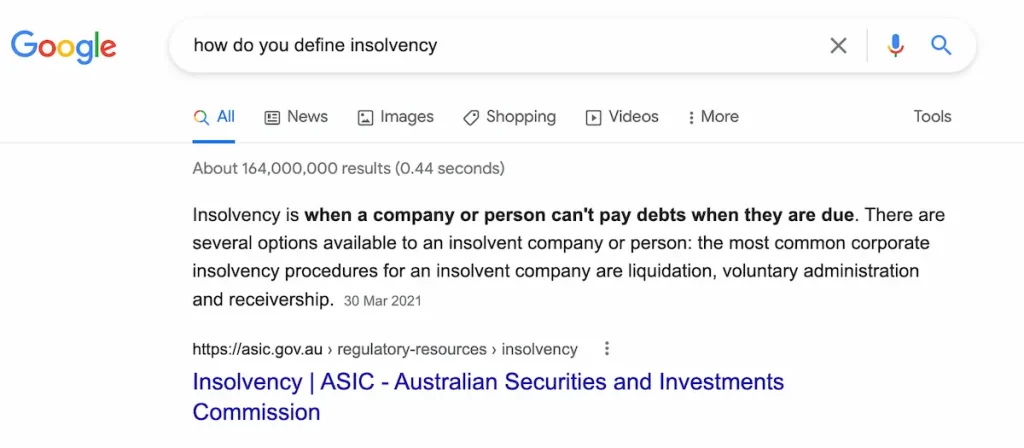
Value of SEO for lawyers vs Google Ads
When a law firm buys a Google Ad, the lawyers’ website appears at the top of the search engine results page (SERP) as an ad. Most searchers know that the law firm is paying to be in this position, i.e. that being in this position is advertising, not an endorsement from Google. This is reinforced by the word “Ad” in bold next to the listing.
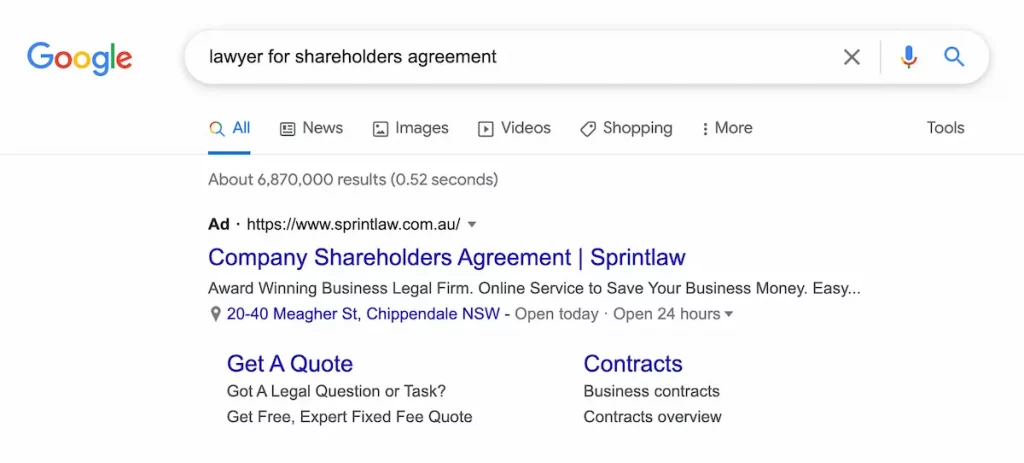
When a law firm’s SEO efforts cause it to rank on the first page of Google, the listing will come after the Google ads and without “Ad” next to the listing.

The advantage of SEO over Google Ads
Google Ads can be effective because:
- They are immediate — as soon as the lawyers start paying, Google starts showing their ads against the chosen searches
- They appear at the top of the page
The disadvantages of Google Ads are:
- As soon as the law firm stops paying, the ads disappear
- The law firm pays every time someone clicks on the ad. Known as “cost-per-click” advertising, these amounts can seem small (dollars per click) but the total ads up quickly
- The majority of searchers scroll past the ads because they’re… ads. (Same as people flipping past ads in magazines, for example.)
The advantages of SEO for lawyers come in where the weaknesses of Google Ads start to appear:
- Continued first page ranking isn’t dependent on continued outlay of cash
- Consumers are shown to favour organic (not-paid-for) rankings because they consider Page One ranking to be an endorsement by Google
Calculating the value of a law firm’s SEO investment
One way to measure the value of your SEO is to consider what the equivalent positioning would cost you with Google Ads.
Say, for example, that you have a Page One ranking that will lead to 100 clicks/month. If it would cost you $3.93 per click to advertise against the same search, your 100 clicks from your organic (SEO) ranking could be said to be worth $393 every month. That’s because you would have had to spend $393 to get those 100 clicks from cost-per-click (CPC) Google Ads advertising.
The value of SEO to the law firm in this example (saving Google Ads spend)
In the case of this example, our client law firm ranks on Google’s first page for 60 search terms. We can calculate what the equivalent positioning would cost with Google Ads because we know:
- The monthly search volume for each of these terms
- The firm’s position on the first page (1-10) for each of those keywords (because this tells us how many of those searchers will click on our client’s page)
- The cost per click if we were advertising against those keywords
In this practice area, it would cost our law firm client USD2,400 every month to buy the same clicks that it is earning from its organic rankings.
Also, our client is locking out their competitors. When you appear on Page One, someone else doesn’t.
Finally, and most importantly, some of those clicks are turning into clients. And without the clicks, there wouldn’t be the clients.
Organic rankings are often described as “free”, but that’s not true because it takes work to get to Page One. However, you’re not paying for each click. This works especially well when searches are on the rise for a particular area of law. For example, “insolvency” searches go up during a downturn. The firm that is already positioned to collect searches for “insolvency” won’t pay any extra for the additional clicks (and clients) it collects from those additional searches.
The value of Google ranking to the law firm in this example (foundation laid)
How much work it takes to rank a law firm for a particular search depends on many things. An important consideration is: What do you already rank for?
The more keywords that lawyers already rank for, the faster Google is likely to consider the firm a good choice to rank for future legal keywords.
In this case, our client law firm now has Page One rankings for 60 keywords related to this blog post. When the firm launches its SEO campaign to rank for other practice areas, Google will be more open to ranking the firm faster because Google has greater confidence in the firm’s legal expertise.
SEO copywriting tips for lawyers and law firms
When you’re looking to apply SEO copywriting to a law firm, there are two elements.
1. The search engine optimisation
The first element is the SEO. That requires:
- Deep research into what people are searching for (because you’re trying to postion your page as the answer to those searches, and as many of those searches as possible)
- An understanding of the structure of the pages that already rank (because you will not rank in Google with a page that is too different from the pages that Google already regards highly)
- Patience (because Google’s first page is like an oil tanker — it will shift, but it won’t shift fast)
To win at the search engine optimisation part of ranking a law firm website, you have to go further than thinking in terms of head keywords. Head keywords are the obvious ones — like “divorce lawyer” or “insolvency law advice”. These head keywords will be highly competitive. If your law firm’s website isn’t already battle-ready, you won’t get anywhere shooting for head keywords. You need to win a few skirmishes before you can take on battle-tested opponents.
Skirmishes in SEO are what are called long-tail keywords. These are searches that involve more words because they’re more specific. Long-tail searches look like “insolvency advice for a hospitality business”. The downside is that fewer people are searching for such specific answers. The upsides are:
- Those people will likely be more ready to take action (because they’ve gone from general, vague searches to zeroing in on what they need)
- When Google sees you winning skirmishes, it will take you more seriously when you enter battles for hotly contested head terms
Identifying the skirmishes you can win takes skill and you’ll be helped by using the right tools — and understanding what they’re telling you. You need to know how to assess the strength of your website and the weaknesses of the sites that are ranking now. Then you can work out how to nudge ahead.
2. The copywriting element
There is a difference between content writing and copywriting. You can rank in Google by writing what’s now called “content”. Content writing is about educating, informing and entertaining, but if you want the reader to take an action, you need copywriting. And if you’re going to the trouble of getting people to your law firm’s website, chances are you’d like to persuade those people to do something.
There’s a lot that goes into persuading humans to do things, but based on reviewing hundreds of law firm blog posts, there are some quick wins that suggest themselves often.
To turn up the heat on your copywriting, you need to:
- Think about reading ease. Lawyers like to write like the stuff they read at university, but that stuff is hard to read. (And I know because I studied law at university.) The problem with writing at that level is that it’s offputting. Your readers want information they can act on; they don’t want to have to decode it first. Also, when you can’t write about the law plainly, the reader assumes you won’t be able to talk about it plainly either. And your clients want someone who can be clear with them, so show them you can be clear with them from their first encounter with you: your web content. (This advice often leads to lawyers saying, “But my clients are sophisticated, university educated…” It doesn’t matter. Everyone appreciates clear writing.)
- Empathise. People don’t generally go to lawyers for carefree things. That means your reader is probably stressed, uncertain, under pressure. People in those situations want someone who sounds like they’ll be on their side.
- Include a call to action. Lawyers often end their blog posts with some information about the author. That’s it. It’s understandable thinking: I’ve just told you some useful things and I’ve given you my name, so you’ll dig out my contact details if you think I can help. But that’s not how it works online. Tell your reader what you’d like them to do — call you, email you, download this guide…
The state of play
At the time of writing this case study, the blog post we wrote for our client is responsible for 88 per cent of the traffic to the law firm’s website. However, that will change. The client has seen the value of new enquiries in this area of law. Now, it wants the same rising tide applied to other lucrative practice areas. The post will continue to bring in the same traffic, but there will be more traffic overall, so no one post is likely to account for almost 90 per cent of the volume.
Do you want your law firm to rank for valuable practice areas?
If you’d like your law firm to show up when potential clients ask Google about their problems, we can teach you SEO or we can do the SEO research for you and deliver one of our ranking packs for you — a ranking pack is a collection of blog posts designed to move the Google needle for your lawyers.
If you’d like to talk about a ranking pack, we’d love to talk about how we can help. Please use the form below or email us.
